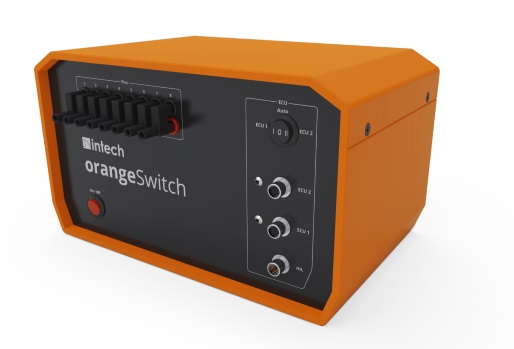
Modern vehicle development without prior simulation would be inconceivable today. That is because numerous electronic control units operate in today’s cars and their functionality has to be tested during the development phase. This is where the automobile industry counts on what are called HiL (hardware in the loop) systems. The engineering company in-tech has developed the in-house modular orangeHiL system for complex simulation processes. In combination with the orangeSwitch, it makes highly automated test procedures possible. “The patent-pending orangeSwitch makes it possible to automatically switch between control units on the HiL or test bench. This can improve capacity utilisation on the test bench and decrease mechanical defects,” explains Managing Director Christian Wagner.
The orangeSwitch is highly scalable and independent of the HiL system being used. “This means that the orangeSwitch can be fabricated with many different pin numbers, for example as an 8-pin combination instrument or also a 280-pin motor controller – the concept is easily scalable here,” says the Managing Director. A breakout box can be integrated directly as an option in order to enable access to some or all pins. Control of actuators or additional monitoring of signals is possible as well.
Extensive test routines for control units – even overnight
If a job is created for a HiL system in which several hardware variants of the same control unit are to be tested, the user now has the following option: instead of connecting these variants to the HiL individually, all of them are connected simultaneously to the orangeSwitch. The switch is in turn connected to the HiL, precisely at the location where the currently tested ECU (Engine Control Unit) variant was connected. Then the orangeSwitch is connected to the test automation PC via Ethernet. The specially supplied orangeSwitch control plugins can also be integrated into the test automation software. Test cases for all control unit variants are set up in the test automation tool, which is configured so that it switches to the next variant once all tests on an ECU variant have been completed. Then the test sequence is started and the respective employee can devote himself to other tasks. Each ECU variant connected to the switch is automatically validated, one after the other. For each variant, all relevant test cases are run before switching to the next variant. “When the employee returns to the system, for example after the weekend, he can evaluate the test results of all variants,” the Managing Director explains.
Project report: increasing the validation depth at BMW
The system is currently being used by BMW. Huy Chau, Project Manager Charging and Preconditioning Interior/HV Battery in the “Networked E-Mobility” department at BMW, explains: “One of our department’s goals at BMW is to significantly increase the validation depth in the area of networked functions by introducing new methods and processes. The fully automated execution of test cases is a significant efficiency measure to achieve a greater validation depth without added validation effort. In combination with the orangeSwitch from in-tech, we are now able to automatically validate the full scope of functionality for stationary air conditioning in electric vehicles during and especially outside of regular working hours.” This includes air conditioning of the vehicle interior for a departure time selected by the customer and the preferred charging of the HV battery in a certain period of time.
Problem-free integration thanks to the included software package – BMW draws positive conclusions
The orangeSwitch supports the tool-assisted control of the affected vehicle components. Integration into the existing infrastructure at BMW was straightforward due to the included software package. The system was also put into operation quickly thanks to on-site support from in-tech. Due to the high flexibility and fast conversion possibilities of orangeSwitch, expansion to different vehicle configurations is also possible without great effort. “The system has already proven its worth in operation. Stability and robustness in particular are great benefits. No manual intervention from the outside is required, which is a prerequisite for unattended operation outside of working hours,” concludes Huy Chau.
Source: in-tech
Advertisement
Learn more about Electronic Products Magazine





